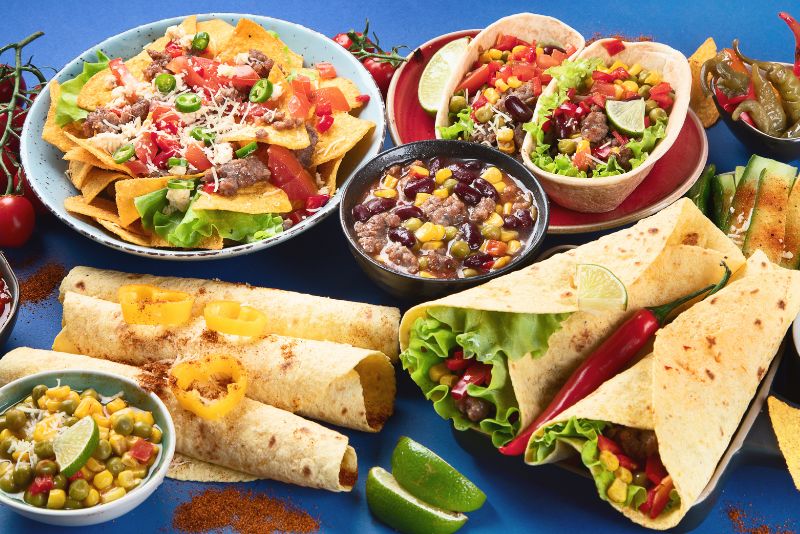If you’re curious about what do Mexicans eat for breakfast, then you’ve come to the right place. This blog post will explore the various ingredients, flavors and dishes that make up a traditional Mexican breakfast so that you can get a taste for this vibrant cuisine. From hearty huevos rancheros to delicate chilaquiles, Mexican breakfasts have something special to offer everyone!
Let’s dive into this vibrant culture and discover the morning delights it has to offer!
Table of Contents
What Do Mexicans Eat for Breakfast?
A typical Mexican breakfast consists of Enmolada, Pozole, Tortas, Chiltomate, Chiles en Nogada, Tacos de Papa, Migas, Tostadas, Sopa de Lima, Elote, Chilaquiles, Huevos Rancheros, Enchiladas, etc.
Breakfast is the most significant meal of the day. Anytime between 7 and 10 in the morning is when it happens. Breakfast on a typical workday is simple to find on the street or frequently prepared in traditional homes.
Then comes a filling comida (lunch), which is served between 2 and 5 pm, followed by dinner at around 7 pm. For people like office professionals, returning to work after lunch is quite challenging because it occurs in the middle of the workday.
This is so that they can have a four-course lunch, which typically consists of soup, rice or pasta, a main dish, and dessert. They will therefore have to refrain from taking their usual post-meal snooze.
Cena, also known as merienda, is a light supper or snack that helps the body get through the night. Since your body doesn’t require much energy to sleep, many people think that eating smaller meals at night is a healthy eating strategy.
Mexicans frequently consume stews and hearty broths, such as those that come with barbacoa, which is lamb wrapped in agave leaves and grilled in an underground pit furnace, and birria, a beef stew with tomato, chiles, and spices that originated in Jalisco.
Traditional Mexican Breakfast
Have you known about traditional Mexican breakfast? Have you ever eaten them yet? This list of traditional Mexican breakfasts is just full of excellent breakfast options you can find in Mexico, which you will love if you like food in general.
1. Enmolada
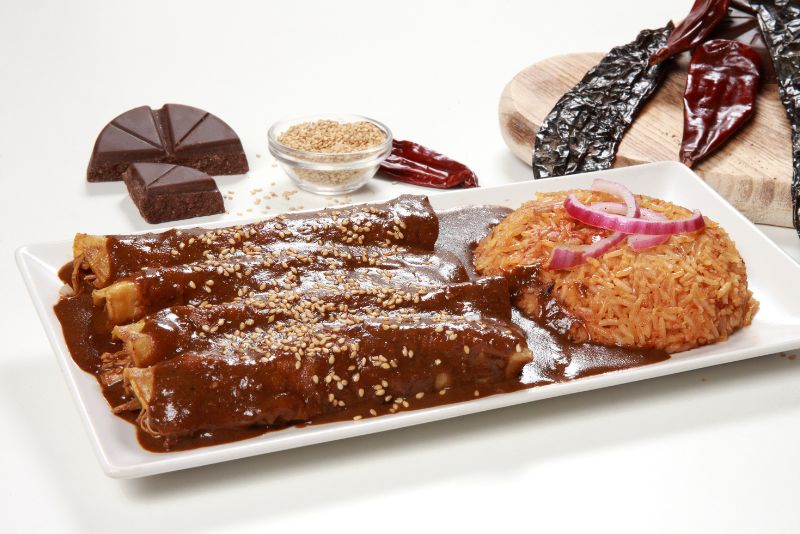
An enmolada is a rolled corn tortilla from Oaxaca that is frequently filled with shredded chicken and cotija cheese, covered in black mole, and topped with sesame seeds and cheese crumbles. Imagine it as the more sophisticated cousin of the enchilada.
Enchiladas coated in mole sauce are what Mexican enmoladas are. Although the enchiladas can be filled with a variety of items, chicken and shredded cheese are the most popular fillings. The tortillas are fried first, then filled with chicken and cheese and dipped into the heated mole sauce.
The enmoladas are covered with additional mole sauce if desired. Sliced onions and finely chopped coriander can be added to enmoladas as a garnish before serving. This delicious Mexican recipe is a perfect illustration of how leftover mole sauce can be used to make a new dish.
2. Posole (or Pozole)
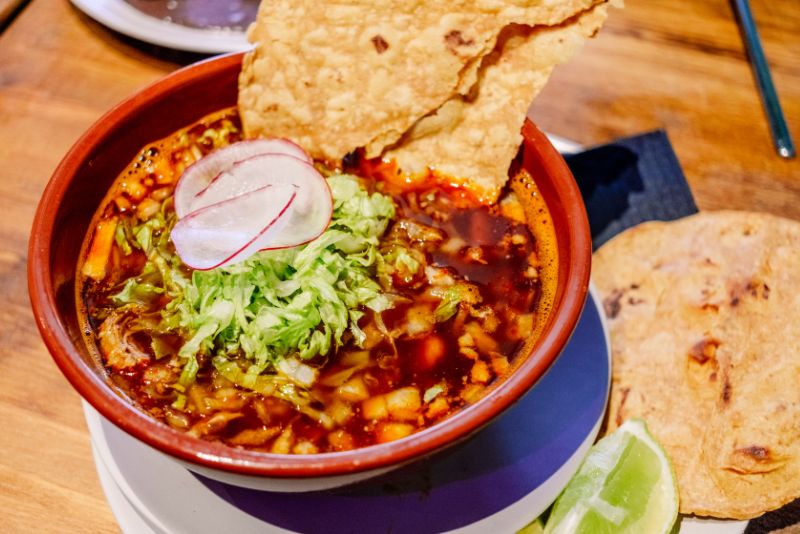
Hominy (hulled corn kernels, also known as maize), the base of this substantial soup, is cooked with red chiles, flavorful spices, tomatoes, and pork shoulder.
It is then topped with shredded cabbage, chopped onions, sliced radishes, and lime juice and served with warm corn tortillas. Because the Aztecs revered maize as a sacred plant, posole is typically saved for rare occasions.
Warm corn tortillas are typically served with pozole to help them absorb the flavorful soup. This dish is pretty great for breakfast if you want a flavorful taste of soup in the morning!
3. Tortas
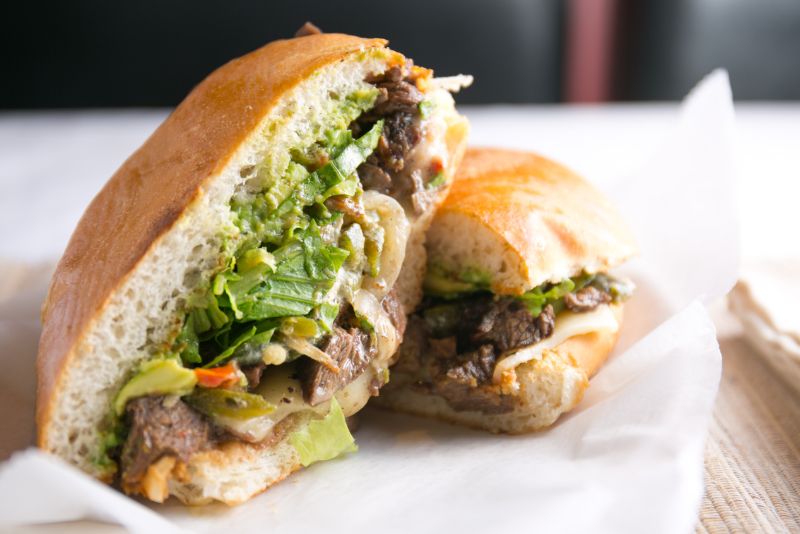
Mexican sandwiches called tortas are frequently served hot—grilled or pressed—but they can also be eaten cold.
While the fillings—some combination of meat and vegetables—might be varied, the roll is usually made of one of Mexico’s most recognizable breads, the bolillo or telera.
Bolillos resemble baguettes the most in appearance since they are tapered on both ends, slightly denser, and have a crusty outside.
Teleras, on the other hand, tend to be softer and have a more rounded form. The dish is fully packed with vegetables and meat combined with awesome breads that will leave you with a satisfying breakfast!
4. Chiles en Nogada
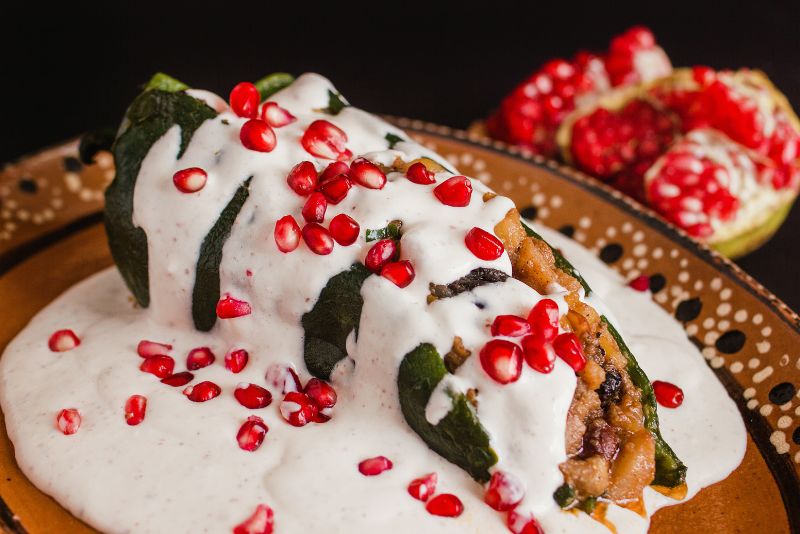
The cuisine most closely linked with Independencia, or Mexican Independence Day is chiles en nogada. On September 16, we mark the day that Spain’s rule over Mexico came to an end.
There are a few different versions of how this dish came to be, but the majority of people think nuns invented it and then delivered it to military commanders in Puebla, Mexico, soon after Mexico broke away from Spain.
Regardless of its precise ancestry, the presentation’s vibrant colors—white sauce, green chiles, and crimson pomegranate arils—intentionally represent the Mexican flag. The recipe also makes excellent use of Puebla’s bountiful harvest from the autumn, which naturally includes the poblano chili pepper that bears its name.
The meal is composed of stuffed poblanos with picadillo, which is a combination of pork, diced fruit, and spices, covered in a walnut cream sauce, and topped with pomegranate seeds.
5. Chiltomate
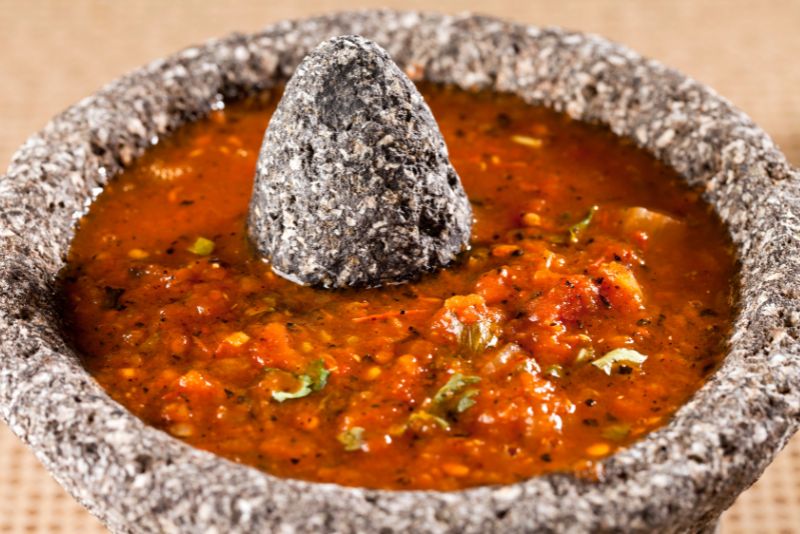
The foundation of Mexican cuisine is salsa, according to many people. And the traditional Yucatecan dish chiltomate most definitely fits that definition.
The Mayans, who inhabited what is now known as the Yucatán Peninsula, are thought to have been the first people to create this roasted tomato and chile salsa.
Chiltomate is a staple of contemporary Mayan cuisine due to its straightforward ingredients, straightforward preparation, and sweet-spicy flavor.
6. Tacos de Papa
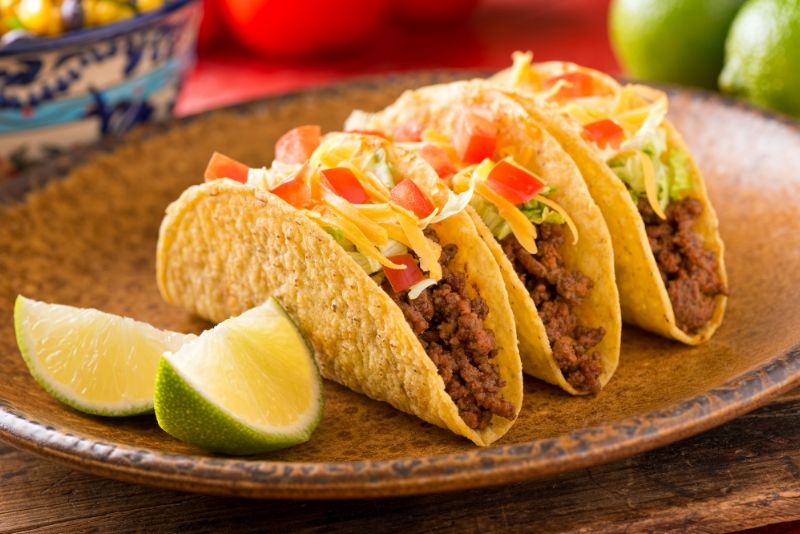
In tacos de papa, mashed potatoes with cumin spice are wrapped in a corn tortilla and deep-fried till crispy. You may see them garnished with several ingredients, including crumbled queso fresco, shredded cabbage, salsa verde, sour cream, and pico de gallo, depending on where you eat them (in Mexico and the United States).
7. Sopa de Lima
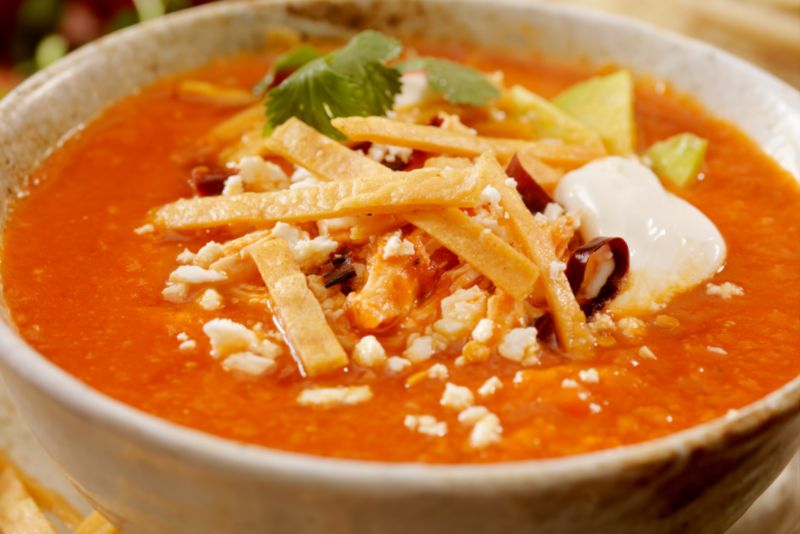
The tortilla soup served in Mexican and Tex-Mex restaurants all around the country is quite similar to sopa de lima.
Both are created with a flavorful chicken broth and served with shredded meat and corn tortilla strips that have been crisp-fried to give flavor and texture to the soup. But what distinguishes them, starting with the broth, are the minute flavor variations.
The Yucatán-born soup de lima is the local version of grandma’s chicken soup. The main ingredients are chicken, corn tortillas, avocados, habaneros, and lime. It’s essentially a large bowl of comfort food.
8. Cemita Poblana
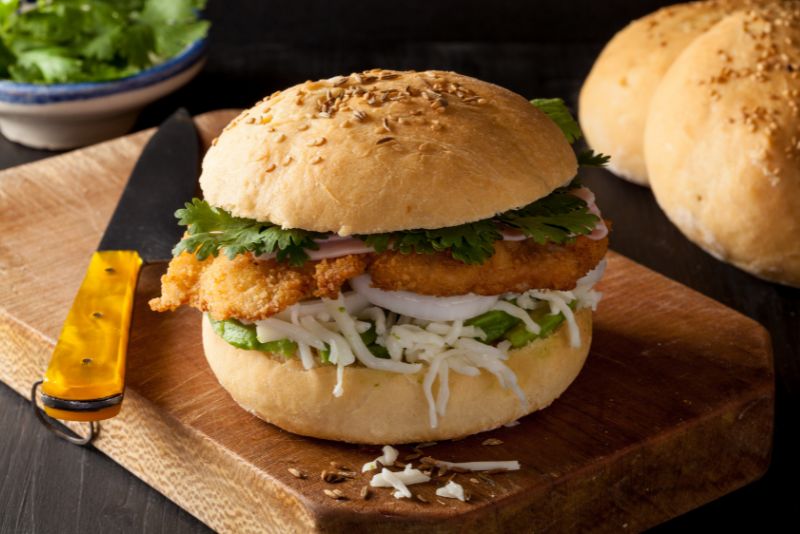
This incredibly delicious Cemita Poblana is made of breaded chicken milanesa that is stacked high atop a sesame seed bun. Cemita, commonly known as cemita poblana, is a breaded chicken, pork, or beef-filled oversized torta (sandwich).
However, a cemita wouldn’t be complete without the clingy quesillo or Oaxacan string cheese, the creamy avocado, and the smoky chipotles. Cemita, a typical delicacy from Puebla, Mexico, gets its name from the bead that this filling torta is served on.
You can frequently obtain a sweeter variety of cemita bread if you attend your neighborhood big Mexican bakery.
Yummy with a hot cup of coffee! Serving this cemita poblana with the enormous chicken milanesa stacked within the sandwich is one of its amusing features.
9. Mexican Migas
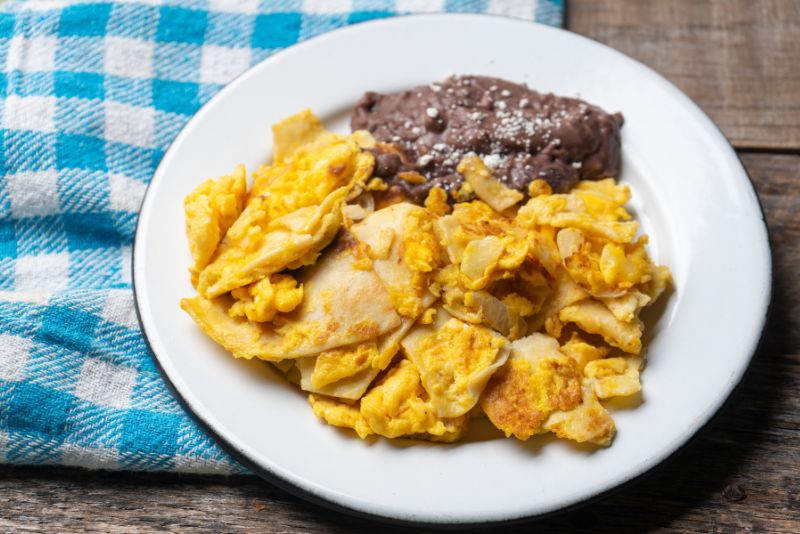
Migas are fantastic because they take few ingredients, can be prepared quickly and easily, and effectively utilize leftover tortillas. They are certainly quite tasty as well.
Migas are made of crunchy tortilla pieces combined with scrambled eggs. Additionally, you could mix in some diced vegetables.
The Spanish word “Migas” literally translates to “crumbs.” Although Mexican Migas don’t contain bread, the original Migas dish from Spain did, which is how the dish got its name.
The finished meal will indeed have some crunchiness to it because the tortilla pieces are lightly fried in a pan and frequently those same pieces are leftover tortilla chips. The crispness of the tortillas, in my opinion, creates a good contrast with the eggs’ soft texture.
Popular Mexican Breakfast
After a list of traditional Mexican breakfasts, what do you think? Do you think it is enough? Here, we have a continued list of popular breakfast that is enjoyed by Mexicans, and if you are in Mexico but haven’t tried any of them, try them once! It is good!
10. Chilaquiles
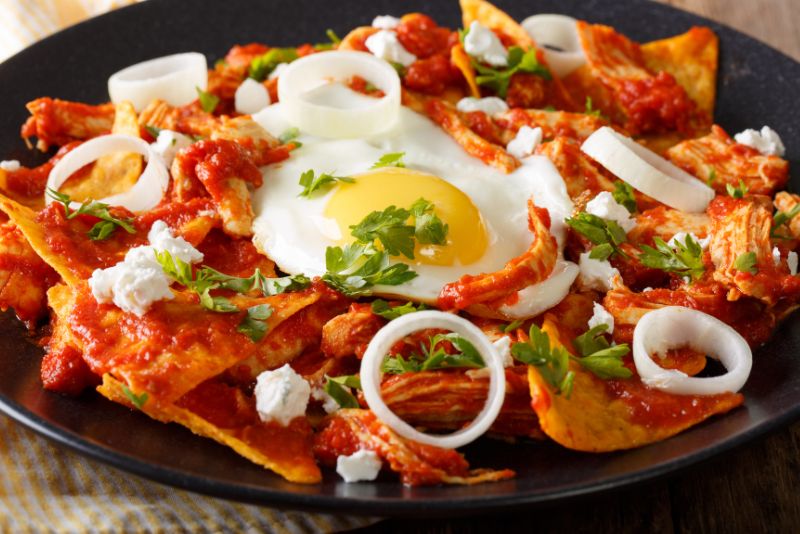
One of the easiest Mexican dishes is chilaquiles, unless you like to make it complicated with all the extras you can think of.
Migas and chilaquiles may have similar appearances, but there are several significant differences. First, unlike chilaquiles, which do not require eggs but are a variation of the migas dish.
Chilaquiles, on the other hand, are always prepared in salsa and are served as an optional garnish with migas.
For chilaquiles, you start with crisp tortillas; in fact, some people start with tortilla chips as a quick fix. The tortillas in migas are typically softer. Of course, using stale tortillas in both recipes is a great idea.
11. Tacos al pastor
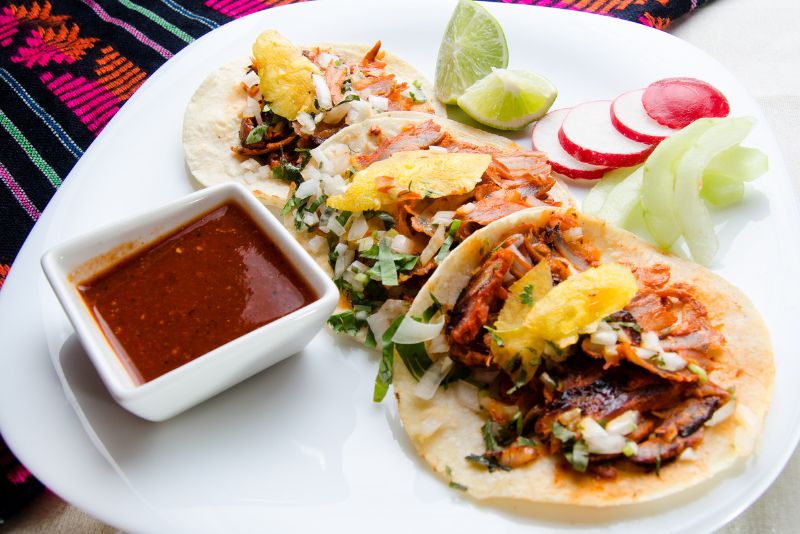
With beginnings in the 1920s and 1930s and the immigration of Lebanese and Syrians to Mexico, this traditional cuisine is among the most well-known types of tacos today.
The Mexican delicacy tacos al pastor has Lebanese roots. This “shepherd style” dinner, which is a variation on lamb shawarma, is seared with flavor and can be made (and eaten!) in a variety of ways.
Most likely, the shawarma, or spit-grilled meat, that Lebanese immigrants introduced to Mexico is what gave rise to Al Pastor.
It also resembles Greek gyros and Turkish doner kebab. While shawarma is often produced with lamb (thus the term “shepherd style”), gyros and tacos al pastor are made with pork in Mexico.
12. Tostadas
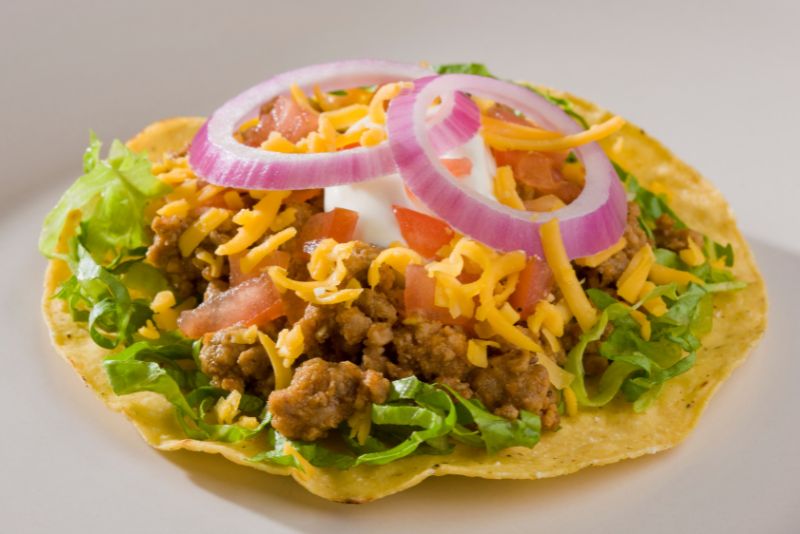
How should old tortillas be used? Why you guessed it—fry them! Tostadas, which mean “toasted,” are a straightforward but tasty delicacy made of maize tortillas that are cooked in hot oil until they are crisp and golden.
A tostada’s structure is quite straightforward; it resembles a taco but is flat. Typically, a fried corn tortilla is used as the base, and then refried beans, cheese, salsa, and other ingredients are added.
You can have fish tostadas, shredded chicken tostadas, or beef tostadas since anything that might go in a taco can go on a tostada.
13. Elote
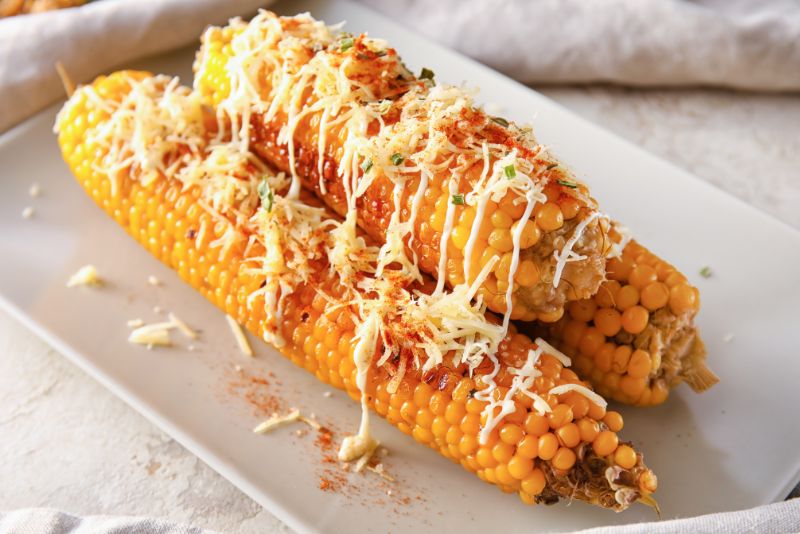
Nearly every metropolitan street corner in Mexico has a vendor selling elote, the word for corn on the cob.
The corn is customarily boiled and served with the kernels removed from the cob, either in cups or on a stick to be enjoyed like ice cream. Then, a ton of salt, chili powder, lime, butter, cheese, mayonnaise, and sour cream are added.
14. Enchiladas
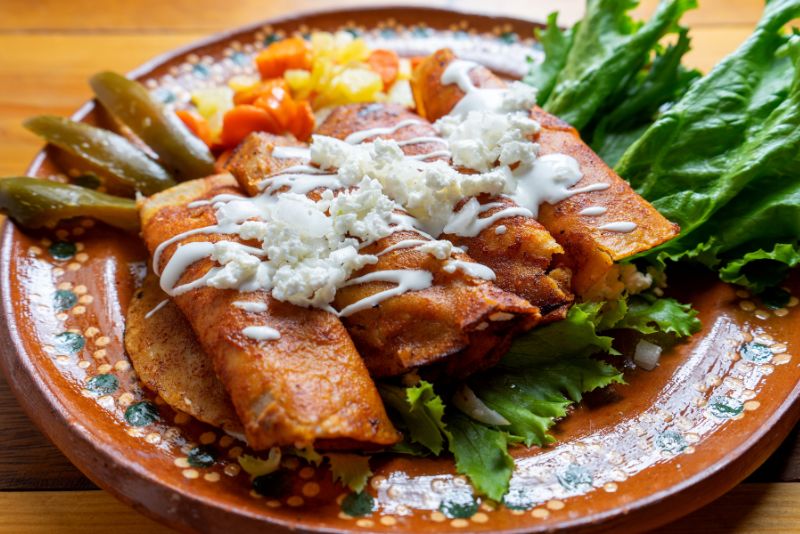
Enchiladas have roots in the Mayan era, when inhabitants of the Valley of Mexico would consume maize tortillas encased in little fish.
One of the most adaptable Mexican foods is enchiladas. Fill them with salsa, cheese, and whatever else you have on hand, then bake them until they are bubbling and delicious. They are the ideal quick breakfast for the workweek.
Today, tortillas made of both corn and flour are utilized, and they can be filled with any combination of meat, cheese, fish, beans, or vegetables. A chili sauce is then drizzled over the packed tortillas, creating the ideal Mexican breakfast.
15. Mole

The thick sauce known as mole, which is pronounced “mol-eh,” is said to have originated in three different states.
There are many different kinds of mole, but they all have about 20 components, including one or more types of chili peppers, and they all need to be continuously stirred for a long time.
The mole poblano, a rusty crimson sauce commonly served with chicken or turkey, is arguably the most well-known mole.
16. Guacamole

The Nahuatl word “ahuacamolli,” which combines the words “ahuacatl” (avocado) and “molli,” gave rise to the Spanish name “guacamole” (sauce). It was traditionally prepared by the ancient Aztecs by mashing avocado with some tomato and chili in a molcajete.
Today, various varieties of guacamole can be found at chic cafeterias that serve young crowds brunch as well as in contemporary culinary circles as a savory spread for toast. It is still offered in its most authentic form in most taqueras and Mexican homes. Such is the scope of this remarkable dish.
Guacamole is a popular dip or side dish that is made from mashed avocados, onions, tomatoes, lemon juice, and chili peppers (and occasionally a garlic clove or two).
17. Tamales
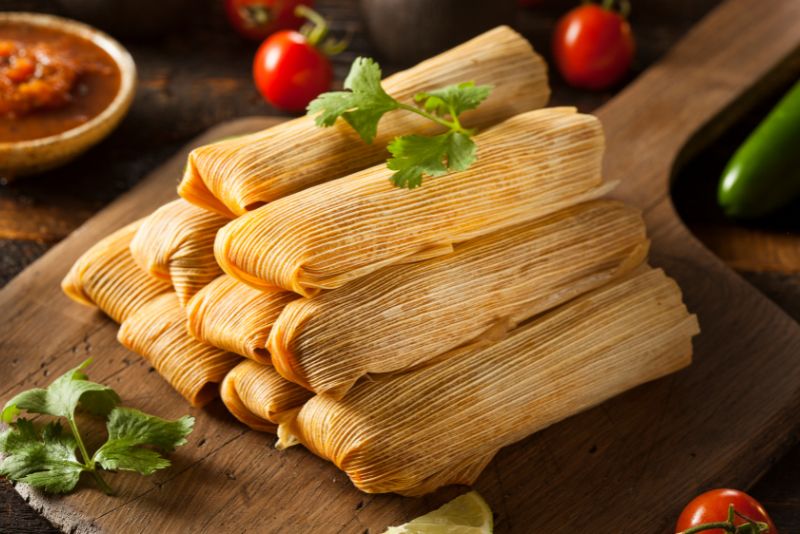
A full dinner in a portable form is a tamale. Tamales are typically produced by combining maize dough (masa) with filling, wrapping them in a banana leaf or corn husk, and steaming them.
When the corn masa is steam-cooked, it becomes firmer, and the tamale can be opened and consumed on the move. Tamals, tamalitos, and pasteles are just a few of the various names and varieties of tamales.
Hallacas are popular in Venezuela, especially around Christmas. In the Andes, humitas are cooked with freshly ground maize rather than the more common dried cornmeal known as masa harina (or masarepa in some regions).
The Aztec, Mayan, and Inca nations required substantial sustenance on the go to carry into battle, so they created tamales.
18. Huevos Rancheros
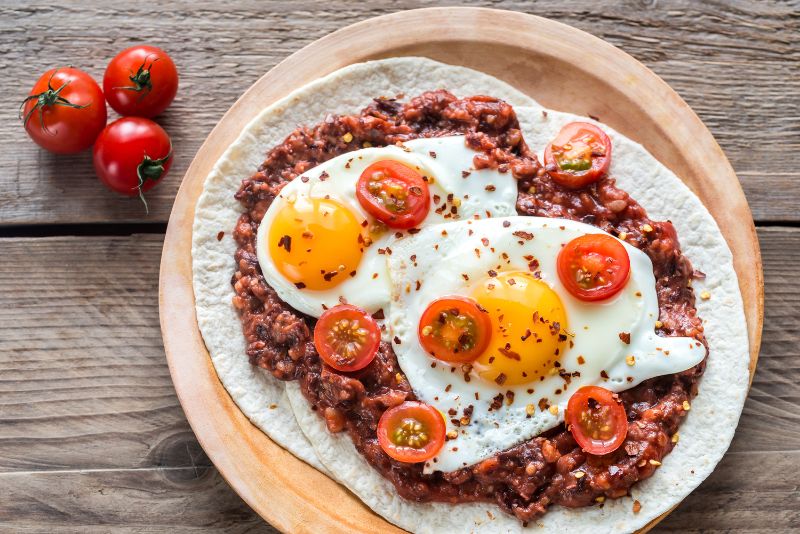
Huevos rancheros are one of the most popular breakfast options.
Rancher’s eggs, which get their name from being traditionally served in rural farms, are made out of a fried egg on top of a corn tortilla that has been lightly fried and is topped with a hot salsa made of tomatoes and chilies.
For good measure, avocado, eggs, onion, and cilantro are included.
19. Huevos Divorciados
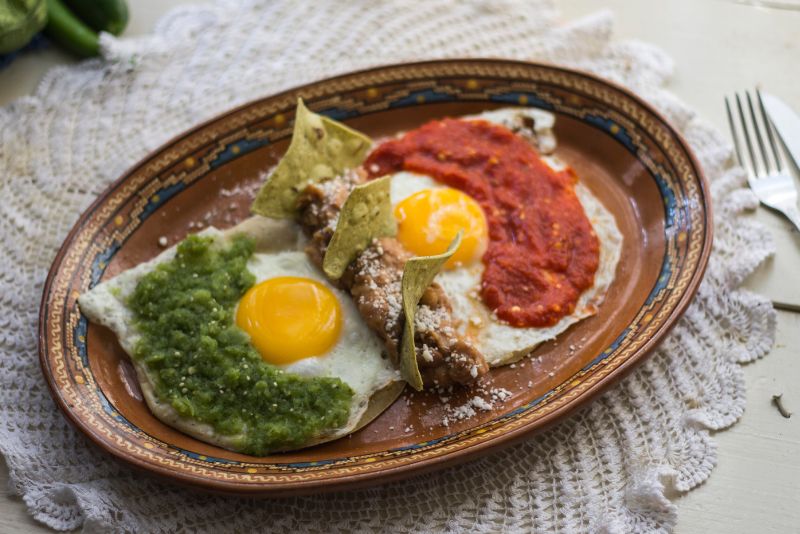
A variation of the traditional huevos revueltos are huevos divorciados.
The same delicious tortilla and egg combination is still available, but this time each egg has a different sauce—one made with tomatoes and the other with tomatillos.
20. Molletes
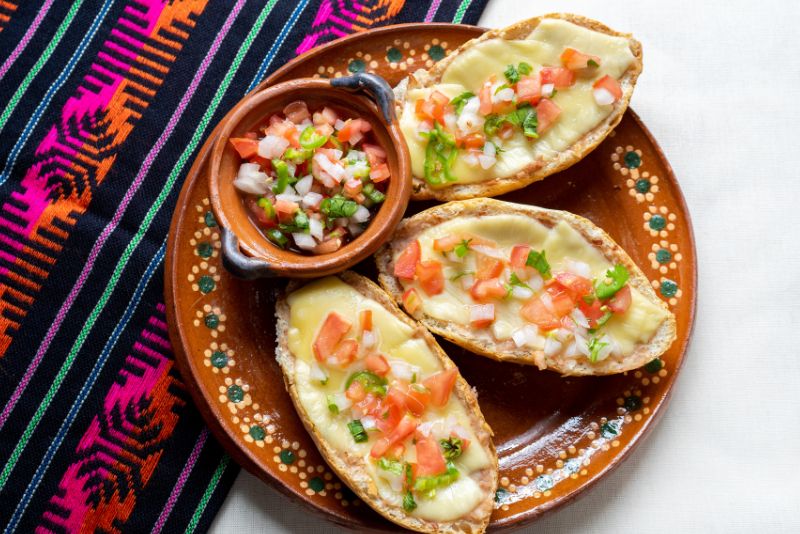
Molletes are a quick and delectable way to start the day when you combine beans, bread, and cheese. A bolillo, a type of savory Mexican bread, is simply cut in half, filled with beans, and topped with cheese to produce molletes.
Place there till the cheese melts, and done! You can add jalapenos to make it spicier or bacon and pico de gallo to make it more appealing to you.
Other toppings, such as chorizo, chilorio, eggs, etc., are added according to the region of Mexico. The salsa fresca is what gives the distinctive touch (pico de gallo). This salsa is by far the most popular one served with molletes.
21. Menudo
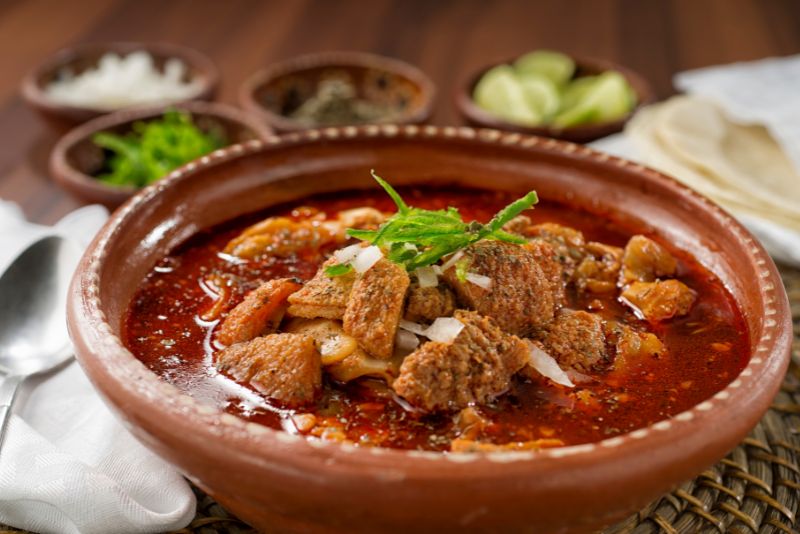
Pancita, also known as menudo, is common breakfast food in Mexico, especially the morning after a wild night.
Menudo, a hearty beef stew made with tripe, onion, cilantro, and a red chili-based sauce, is reputed to be a hangover cure.
Grab a big pile of tortillas and dive into this. It is a great breakfast option for you especially if you like a hearty meal that is going to give you a warm feeling.
FAQs
1. What is the most common Mexican breakfast?
One of the most well-known breakfast items in Mexico, chilaquiles are deep-fried tortillas that have been covered in a red sauce made of tomatoes or a green sauce made of tomatillos. They are then topped with grated cheese, onions, and cream.
A heaping plate of chilaquiles, or tortilla chips, covered in red or green sauce and topped with chicken or eggs, crema, onion, and cheese, is a traditional breakfast dish in Mexico.
3. What do Mexicans eat for lunch?
Mexicans do eat lunch, here are the lunch options:
- Soft Taco Wraps and Burrito Wraps: To wrap up all of those delicious leftovers or quickly cooked components to construct a classic Mexican meal, soft taco and burrito wraps are a necessity.
- Refried Beans and Cantina Beans: Refried beans and cantina beans are excellent options to keep on hand for your burritos, tacos, and quesadillas. They offer you protein as well as delicious flavor and texture.
4. Do Mexicans eat tacos for breakfast?
Even though tacos are traditionally eaten for breakfast in Mexico, they don’t have anything in particular breakfast-like about them. The same tacos, which usually have fresh tortillas topped with a filling hearty stew, can be enjoyed for lunch or dinner.
Conclusion
After reading this article, you will know what kind of food Mexican breakfast is, and of course, there are a lot of breakfast options for Mexicans, such as Guacamole, Chilaquiles, Tostadas, Elote, etc. All of them are simply delicious and very Mexican-like. Thanks for reading this article! Let me know your thoughts in the comment below!
